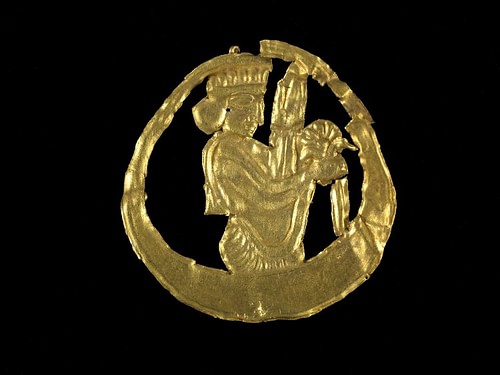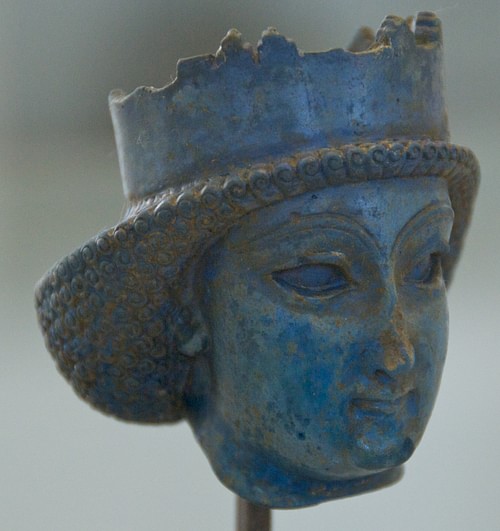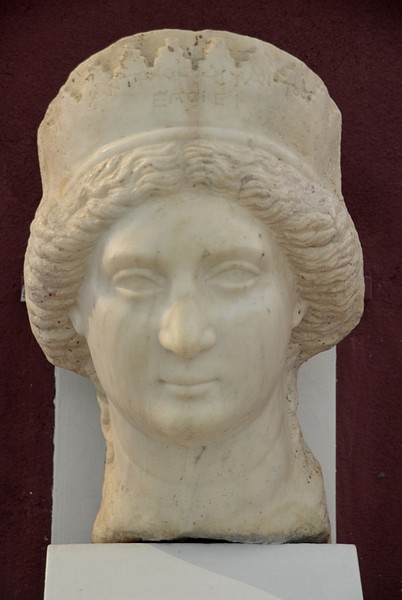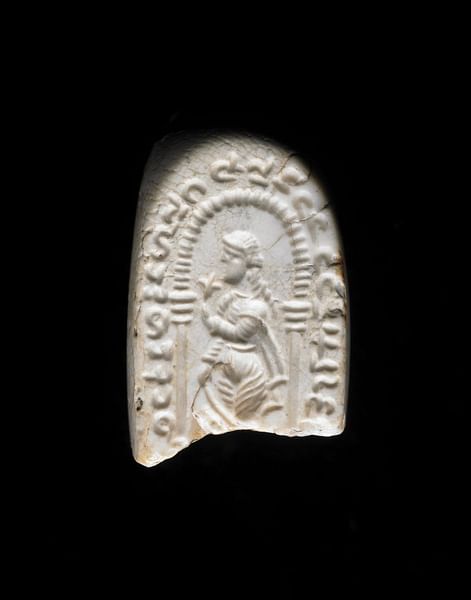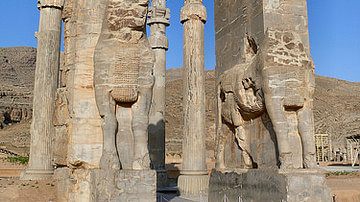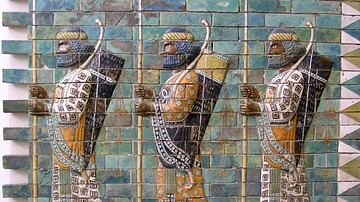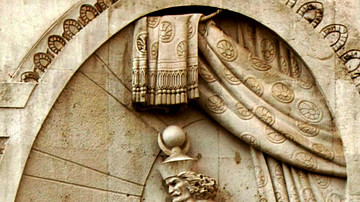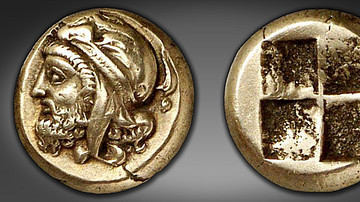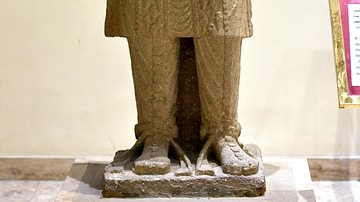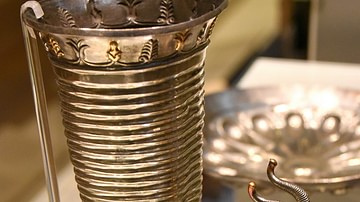Women in ancient Persia were not only highly respected but, in many cases, considered the equals of males. Women could own land, conduct business, received equal pay, could travel freely on their own, and in the case of royal women, hold their own council meetings on policy.
Titles of respect accorded to royal Persian women seem to have derived from the earlier Elamite culture and, most likely, the Median Empire which was the immediate precursor to the Achaemenid Persian Empire (c. 550-330 BCE) founded by Cyrus the Great (r. c. 550-530 BCE). Cyrus established the Persian paradigm of freedom of religion and expression in his empire but was also responsible for maintaining the dignity and autonomy of women of every class.
This same paradigm was maintained by the Parthian Empire (227 BCE - 224 CE) although, because of a loss of records and artwork following Parthia's fall to the Sassanian Empire (224-651 CE), not as much is clearly known of the details of women's lives during this period. The Sassanian period is well-documented, however, and women's rights were maintained at the same level – or higher – than during the Achaemenid Empire. Persian women would continue to enjoy this high status in ancient Persian culture until the fall of the Sassanian Empire to the invading Arab Muslims in 651 CE. Afterwards, the long-standing recognition of women as autonomous individuals, capable of deciding their own fate, was replaced by the concept of women as second-class citizens, inherently sinful, and requiring male guidance and control.
Women in the Achaemenid Empire
The Achaemenid Empire followed a patriarchal paradigm but, within that framework, women had more rights and responsibilities than in any other ancient civilization except that of Egypt. Women, like men, were defined by social class and rank within that class. The female hierarchy, from the highest to lowest, ran:
- Mother of the King
- Principal Wife (mother of the king's heir)
- The king's daughters
- The king's sisters
- The king's lesser wives/concubines
- Noble women (wives and relatives of courtiers, satraps, military men)
- Military Women
- Businesswomen
- Laborers
- Servants/Slaves
Records substantiating the autonomy of women and their activities comes from the Fortification Tablets, Treasury Texts, and Travel Texts found in the ruins of Persepolis. When Alexander the Great burned the city in 330 BCE, any documents written on parchment were destroyed but those inscribed on clay tablets were baked and so preserved.
The Fortification Tablets come from the reign of Darius I (522-486 BCE), the Treasury Texts from the time of Artaxerxes I (r. 465-424 BCE) and the Travel Texts from various eras. They all have to do with the administration and economics of the empire and the Travel Texts include payments and rations dispensed from the royal treasury for women's travel expenses. These texts relate a significant number of transactions between the treasury and women who traveled on their own for business or pleasure.
Royal and Noble Women
The king's mother and principal wife (known as the Shahbanu, “King's Lady”) traveled on their own as well as with him on military campaigns and in overseeing administrative affairs. They had their own entourage, staff to attend their needs, and were given places of honor at banquets alongside distinguished male guests. The principal wife held her own court, could sign agreements with her own seal, and had unlimited access to the king, even being welcomed at official visits from foreign dignitaries and participating in the meetings.
Some of the most famous royal women were Mandana (Mandane), mother of Cyrus the Great (d. c. 559 BCE), Cassandane Shahbanu, wife of Cyrus the Great (l. c. 575-519 BCE), who was mourned throughout the empire after her death, and Atusa Shahbanu (better known as Atossa, l. c. 550-475 BCE) daughter of Cyrus the Great and wife of Cambyses II (r. 530-522 BCE) and Darius I, but there were many others. Sisygambis, mother of Darius III (r. 336-330 BCE), behaved more honorably than her son after his defeat by Alexander the Great and Alexander's Persian wife Roxanne (l. c. 340-310 BCE) is also recognized for her courage in the face of adversity. The biblical figure of Queen Esther, wife of Xerxes I, is another royal woman of the Achaemenid Period even though she was not Persian by birth.
The king's daughters and sisters served primarily in sealing alliances, treaties, and business deals through marriages but still could own their own lands and conduct their own businesses as could the lesser wives. Women could choose their own husbands, however, and did so when they were not asked to marry for political purposes. Concubines were often non-Persian women and, accordingly, could not marry into royalty but were still respected as women of high rank. Xerxes I (r. 486-465 BCE) added a harem building at Persepolis close to his palace, suggesting the elevated status of the women.
Even illegitimate daughters could wield significant power as in the case of Parysatis, illegitimate daughter of Artaxerxes I (r. 465-424 BCE) who would become the Shahbanu of Darius II (r. 424-404 BCE) and the power behind the throne through her network of spies and the strength of her character. She is probably best known for supporting her son Cyrus the Younger (d. 401 BCE) in his bid to unseat his brother Artaxerxes II (r. 404-358 BCE), an event narrated by the historians Ctesias, Herodotus, and by Xenophon in his Anabasis.
Military Women
Women in the Achaemenid Period could also serve in the military as attested by the written record and physical evidence. Scholar Kaveh Farrokh notes that “tombs attesting to the existence of Iranian-speaking women warriors have [been found in Iran and] also been excavated in Eastern Europe” (128). The best-known female warrior of this era is Artemisia I of Caria who lived during the reign of Xerxes I. She was an admiral in the Persian fleet at the Battle of Salamis in 480 BCE, noted for her courage and skill, and was so admired by Xerxes I that, after the battle, she was given the honor of escorting his sons to safety.
Other notable Achaemenid warrior women were Pantea Artesbod, who lived during the reign of Cyrus the Great and was instrumental – along with her husband – in the organization of the elite military unit of the 10,000 Persian Immortals, Artunis (l. c. 540-500 BCE), a Lieutenant Commander of the army, remembered for her courage and skill in battle, and Youtab Aryobarzan (d. 330 BCE), who served in the army and fell with her brother Ariobarzanes (l. 386-330 BCE) defending the Persian Gates against the forces of Alexander the Great.
Businesswomen
The business activities and travels of businesswomen/merchants and the pay scale for laborers is also noted in the Persepolis texts. A notable businesswoman and merchant, Irdabama, who lived during the reign of Darius I, traveled extensively on business and personally oversaw production and trade in the region of modern-day Shiraz, Iran, in Babylonia, Egypt, Media, and Syria. She was one of the wealthiest individuals of her time, commanding a workforce of 480 laborers, and traveling at will with her own extensive entourage. Royal women also engaged in business as in the case of Parysatis who owned a number of villages in Babylonia and traveled there personally to collect the rent.
Laborers, Servants, and Slaves
Women labored alongside men in the workforce and were often supervisors and managers. Highly-paid female supervisors were known as arashshara (“great chief”) and received a larger amount of wine and grain for overseeing the work of often large groups of subordinates. There was no difference in pay based on gender; one's salary was based solely on one's level of skill and experience in the job. Pregnant women, however, received higher wages as did new mothers for the first month after the birth of their child. The mother, midwife, and physician attending the birth also received a bonus if the child was male. Sons were preferred over daughters but there is no evidence of female infanticide or the practice of exposing an unwanted infant to the elements.
Slaves in the Achaemenid Period – and throughout the history of ancient Persia – were treated like servants, received compensation for their services, and had a much higher standard of living and quality of life than slaves anywhere else in the ancient world. Under the laws initiated by Darius I, slaves could not be mistreated, beaten, or killed with impunity and a slave-owner or master of an estate who did so would face the same penalty as if the victim were a free citizen of the empire.
Parthian Women
Knowledge of women during the Parthian Period is not as complete as those of the Achaemenid Empire because of the destruction of so many records and works when the empire fell to the Sassanians in 224 CE. Further, however, the Parthians decentralized the ancient Persian government in an effort to avoid the perceived weakness of the earlier Seleucid Empire (312-63 BCE) and so there was no central repository for records as there had been in the time of the Achaemenids. Scholar Maria Brosius notes:
The sources do not permit a detailed discussion of the ranking order among the women of the court, nor of their possible political influence and economic independence. On the basis of Achaemenid and Seleucid practices, one can only hypothesize that Parthian royal women, too, owned land and estates, as well as manufactures. (Encyclopedia Iranica, Women, 10)
Brosius also makes clear that no information is available on the legal or economic status of women during this time nor, for the most part, even what they wore or their level of autonomy. It is believed, based on the evidence available, that women continued to be regarded in much the same way they were under the Achaemenid Empire and were accorded the same level of respect.
Royals
The lifestyle and activities of royal Parthian women seem to have mirrored those of the Achaemenid Period or, at least, of royal women of the Seleucid Period which continued many of the Achaemenid policies. One example of this concerns marriage contracts in that Parthian monarchs continued the Achaemenid practice of marrying members of their own families but, for royalty, this was not considered incestuous. The Parthians deviated from the Achaemenid model in that concubines could marry into royalty and even assume the title of queen.
The best example of this is Musa (also known as Thermusa, r. 2 BCE - 2 CE) who was presented to the Parthian king Phraates IV (r. 37-2 BCE) by the Roman emperor Augustus (r. 27 BCE-14 CE) as a concubine in concluding the treaty over Armenia in 20 BCE. Musa was able to win the favor of Phraates IV and became his principal wife before having him poisoned and elevating her son, Phraates V (r. 2 BCE-2 CE), to the position of co-ruler with herself.
Military Women
Evidence for women in the military during this period comes from inscriptions and excavated tombs. Kaveh Farrokh writes:
A summary of a report made by the Reuters News Agency in 3 December 2004, entitled `Bones Suggest Women Went to War in Ancient Iran' noted that DNA tests made on a 2,000-year-old skeleton of a sword-wielding warrior in northwest Iran have shown that the bones belonged to a woman. The time length of 2,000 years would place the warrior-woman in the Parthian era…other ancient tombs belonging to Iranian women warriors have also been excavated near the Caspian Sea in northern Iran. (128)
The most famous woman warrior of this period was Sura (d. c. 224 CE), daughter of the Parthian king Artabanus IV (r. 213-224 CE), who also served as his advisor and general of his army. She led her father's forces against the armies of Ardashir I (r. 224-240 CE), who toppled the Parthian Empire and founded the Sassanian. After Ardashir I killed her father in battle, Sura sought revenge and is thought to have also been killed by Ardashir in battle sometime after her father's death.
Merchants and Laborers
There is no specific information on female Parthian merchants or laborers but it is assumed that in this, as in other aspects, the Parthians adhered more or less to the Achaemenid model. Slavery in the Parthian period followed the earlier paradigm to such an extent as to be almost non-existent when compared to how the institution was practiced in other civilizations.
Sassanian Women
The Sassanians kept the Achaemenid policies regarding women's place in society but allowed for greater freedom of expression and autonomy. Sassanian royal women wielded more power and influence than their predecessors, are mentioned more often in official records as individuals of note, and were far more frequently depicted in artwork.
Royal Women
Scholars have often misunderstood the high status women held and their place in artistic representation by interpreting works that feature women as depicting deities. Although goddesses do appear in Sassanian art, mortal women are seen far more frequently.
All royal women were known as “queens”, whether they were sisters of the king, daughters, or other relatives. Concubines were excluded from this honor as they were usually foreign-born. The “Queen of Queens” title referred to the highest-ranking woman among the king's wives. The mother of the king was known as Mother of the King of Kings and the monarch's principal wife was called the Empire's Queen. As with the earlier periods, a king's daughters and sisters were married to foreign princes to conclude treaties, alliances, and business deals, but as with the Achaemenids, women could choose their own husbands and marriages were not always arranged by a woman's father. Even in arranged marriages, women exerted considerable autonomy and influence.
The Sassanian queen Azadokht Shahbanu, wife of Shapur I (r. 240-270 CE) was an equal partner in the marriage. A number of modern-day scholars believe it was Azadokht who first brought Greek physicians to the court and initiated the founding of Gundeshapur, which would become the greatest teaching hospital, library, and center of higher learning of its age.
Other royal women of note include Aspas, chief of the secret police under Ardashir II (r. 379-383 CE); Princess Parin, daughter of a high court official under Kavad I (r. 488-496 CE), who was instrumental in negotiations between Kavad I's court and the Byzantine Empire; Zand Shahbanu, wife of Kosrau I (r. 531-579 CE), who advised him; and Purandokht (also known as Boran), daughter of Kosrau II (r. 590-628 CE), who became empress of the Sassanian Empire, reigning from 629-631 CE.
Military Women and Others
Farrokh notes “the presence of substantial numbers of women in Persian expeditionary forces” at this time and how their participation in ancient Persian warfare - “dressed and armed like men” - was noted by Roman historians (129). Farrokh continues:
Women were recruited for combat roles at critical times, one example being at Singara (343 or 344 CE), of which Libarnius reports that 'the Persians enlisted the help of their women'. This strongly suggests that Iranian women, like the menfolk, were trained in the arts of war and capable of wielding weapons when called to duty. (129)
Azadokht Shahbanu, in fact, is frequently noted as being an expert with the sword in addition to her other accomplishments, and the same reference is made to Aspas. The greatest woman warrior of the later Sassanian Empire was Apranik (d. c. 651 CE) who commanded the army against the invading Muslim-Arab forces during the reign of Yazdegerd III (632-651 CE). Her army was defeated but Apranik would not surrender and continued to fight a guerilla war against her enemies until she was killed in battle.
Businesswomen traded as freely as businessmen throughout the Sassanian Empire although there is no singular example of this comparable to Irdabama of the Achaemenid Period. Laborers, servants, and slaves all followed, more or less, the Achaemenid model of employment, pay, and fair treatment. A major difference between the earlier periods and the Sassanian was the emphasis on dancing. Dancing, music, and storytelling have always been central to Persian life and values but the Sassanians encouraged dance to a far greater degree for both men and women. One of the most famous dancers of this era was Zenon, during the reign of Ardashir II, who was greatly admired.
Conclusion
When the Sassanian Empire fell in 651 CE, women's status fell with it and they were considered second-class citizens. Women could no longer travel without a male consort and permission, could not own or conduct their own business, and were no longer free to choose their own mate. Persian women did not simply accept this attack on their rights, however, and joined their men in resisting the oppression of the occupying forces.
The best-known figure along these lines is Banu, wife of Babak Khorramdin (d. 838 CE), who led a resistance cell with him until they were betrayed, captured, and executed under the Abbasid Caliphate. The legacy of strong Persian women continued after Banu, however, and remains a source of pride in the present day. There are a number of Iranian festivals throughout the year honoring the earth, the elements, and women, and on the festival of Esfandgaan – where gratitude toward women is especially emphasized – the stories of the great women of the past continue to be told, not only in their honor but also to encourage the same level of respect for women in the present as the great Persian empires accorded them in the past.
